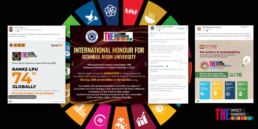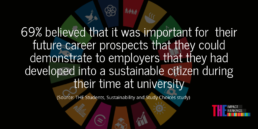Times Higher Education’s 2022 Impact Rankings were released on Wednesday as part of the Innovation & Impact Summit in Sweden. The rankings, first released in 2019, capture universities’ impact on society based on institutions’ success in contributing towardsthe United Nations’ Sustainable Development Goals (SDGs). With the rankings still in their relative infancy, there was a change in the methodology for 2022 to include SDG 17 ‘partnerships for the goals’, and, as a result, we have a lot more movement in the rankings compared to the more established world rankings tables. We look at a few of the key trends and observations of this year’s release and explore what the future may hold.
The Visibility of Non-Western Universities
Unlike other rankings which rely heavily on metrics such as research and reputation, the Impact Rankings measure universities on something accessible to all institutions, regardless of their nature/type, geography, heritage, or cultural practice. The SDGs that underpin the Impact rankings are universal, and so this has seen not only a much larger number of entries from non-western universities but also a much more global mix of institutions taking higher positions. As a network whose entry requirements rely on rankings, the W100 has often lacked the opportunity to engage with many universities in certain areas of the world, such as the Middle East, Indonesia, and Africa. However, the THE Impact ranking has changed this and brought new universities into the limelight, evidenced by the recent joining of Universitas Indonesia, which placed 18th this year, to the network. The Impact Rankings enable non-western universities (and indeed western universities that are traditionally outside of the world top 500) to position themselves as leaders in sustainability and build distinctive collateral for their reputation.
A New Marker for Reputation

To exemplify this trend, in the days after the release, several Indian, Indonesian and Malaysian universities took to LinkedIn to advertise and celebrate their Impact Ranking position. The overall impact of ranking of each university was adjusted to take into account their position nationally and regionally, thereby contextualising their achievement for particular markets.The ‘noise’ around the Impact rankings on LinkedIn show that they could become an increasingly important reputational marker, both in terms of using rankings as a device for communicating brand and reputation,as well highlighting the actual important work universities do in the field of sustainability.
The latter is something we are hearing a lot more about and was in itself an important factor in the creation of the rankings. A 2021 survey by Times Higher Education on the relationship between student’s study choices and sustainability revealed that 79% of students believed that universities have an important role to play in achieving the SDGs, and 69% believed that it was important for their future career prospects that they could demonstrate to employers that they had developed into a sustainable citizen during their time at university. 46% of students had assessed whether a university is environmentally friendly when making their study choice, and 36% had assessed if the university was publicly committed to SDGs. Whilst only 9% ranked a university’s commitment to sustainability as their most important factor (the same as perceived graduate employability prospects), the overall picture is that SDGs and sustainability are becoming increasingly important to students, and therefore paramount for universities to gain reputational advantage in this area.
SDGs are becoming part of wider topics
Indeed, outside of the Impact Rankings, universities are demonstrating their commitment to issues of the environment, sustainability, and the SDGs in other areas of the higher education landscape, particularly in curriculum, assessment, and employability. At the recent AdvanceHE symposium multiple presentations, including two from World 100 member institutions Glasgow Caledonian University and Exeter University, looked at integrating the sustainable development goals into employability-focused curriculum development. Activities were designed to make students into ‘sustainable citizens’ and provide them with skills and knowledge in the area of sustainability that they could apply in their post-university careers.
As we mentioned previously the Impact Rankings have seen a lot of movement since their inception. Will the factors mentioned above continue to spur this movement or should we expect to see these stabilise in the coming years? And will this capacity for genuine competition amongst universities to try and score higher on the SDGs metrics?


